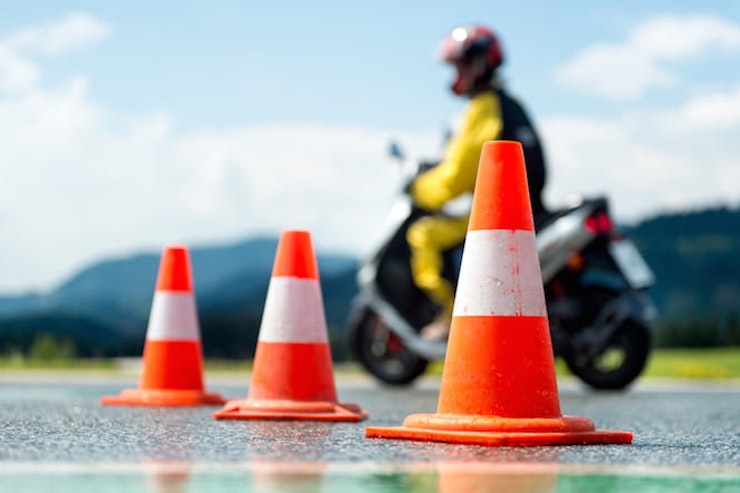CBT made simple | BikeSocial's guide to getting on two-wheels
By Steve Rose
BikeSocial Publisher
02.01.2018
What is a CBT and how do I get one?
Compulsory Basic Training is the first step to getting a motorcycle licence. It allows you to ride a 125cc motorcycle on the road for two years, at which point you either need to take the full bike test or renew your CBT for a further two years to carry on riding. CBT typically takes one day, but there is no time limit. There is also no pass or fail - riders who aren’t ready after one day keep going until they ‘achieve’ the correct standard.
There’s a lot to learn, but don’t think of CBT as a test. Instead, think of it like those gift experiences you buy people for Xmas. Except instead of a ten-minute drive in a racing car this is the first day of the rest of a mind-blowing new life in full colour.
How much does a CBT cost?
The simple answer is typically somewhere between £100-200 depending on where you live and who you do the training with. As with everything, there are some organisations who will do the basics to get you on the road to the required standard as quickly and economically as possible and there are others who take a little more time to go beyond the basic syllabus and help their pupils really get to grips with motorcycling.
How do I choose the right trainer?
All companies offering CBT have qualified instructors. In the last few years though some of the motorcycle manufacturers have set up their own training centres, often via dealerships, to bring some consistency into the kind of facilities and training new riders will encounter. Also, the Motorcycle Industry Association has an ‘accreditation’ scheme for training schools which can prove they meet certain quality thresholds. We’d recommend going to one of these facilities because there’s a lot to learn and good quality training and facilities makes all the difference.
To find an MCIA accredited school in your area, click here.
Do need to do my theory test first?
No. All you need is a valid provisional licence. Part of the training is around hazards and so it helps to have an awareness of safety and we’d suggest reading the Highway Code before you do CBT because much of what you learn will make a lot more sense.
Do I need my own bike and clothing?
No. All centres will provide you with everything you need. Part of the course is a discussion on how to choose the right kit and you will feel better-equipped to make the right choices afterwards.
You can use your own bike if you have one, but it must be fully road legal including tax, MoT and insurance (which might be difficult if you don’t yet have a CBT).
How does the CBT work?
CBT is split into five sections.
Part One is a check to make sure you have correct licence, an eye test (reading a number plate from 20.5 metres) and discussion about motorcycle clothing including the legal requirements.
Part Two introduces the motorcycle. Identifying the controls and each one’s function. Twist a throttle, pull the clutch and brake levers and changing gears with your foot. It feels alien at first, but mastering these controls make a huge difference to your confidence on a bike.
This element of CBT also includes;
Pushing the bike around safely
Putting it on and off the stands
Getting on and off the bike
Starting and stopping the engine
The basic regular safety checks; checking the chain and sprockets, brakes, engine oil level, lights, tyres and steering.
Part Three is riding, away from the road in a safe, controlled environment. How to set off and slow down, use of gears, steering and stopping. In half an hour you’ll swap nerves for excitement.
The final part of the off-road session is learning how to do junctions effectively and safely on two wheels.
Part Four is a classroom session on identifying and dealing with hazards before heading out on the road.
Part Five - The on-road lesson lasts at least two hours with your instructor in contact by radio and typically covers 30-50 miles and a de-brief at the end. The ride covers all common roads and is designed to encounter the important hazards. So expect to do a hill start, some U-turns, various speed limits (including 70mph dual carriageways, where going too slowly is as hazardous as going too fast), roundabouts, traffic lights and junctions.
What happens after the CBT?
Once you’ve completed all five elements satisfactorily, you are awarded a CBT certificate which allows you to ride a machine of up-to 125cc with L-plates for two years.
Are there any restrictions when riding with a CBT?
Yes. You can’t carry passengers or use motorways until you pass your full test.
I only want to ride a small bike, can I keep renewing it forever?
Yes. As the current law stands you can renew your CBT every two years without limits.
If I do my CBT on an automatic scooter, can I then ride a geared bike?
Bizarrely, the answer is yes, although we’d obviously recommend that you take some extra training on the geared bike to make things easier. There is currently legislation going through government that looks set to change this though, in the future you may need to take a geared or automatic CBT, dependant on the bike you wish to ride.

